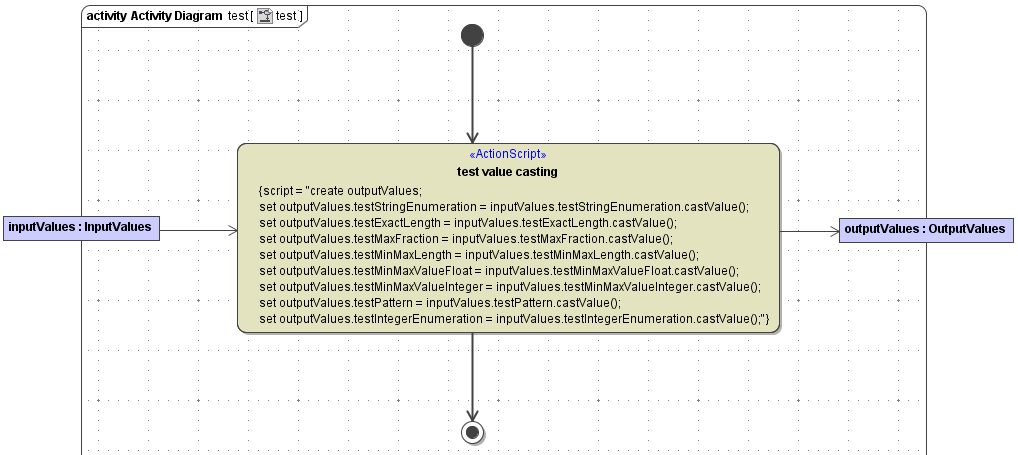| Syntax |
aSimpleChildClassObject = castValue(aSimpleParentClassObject)
|
|---|
| Semantics | Assigns a simple valued object of base class type to an object of its sub-class type. Supported simple value types are: String, Integer, Float, Boolean, and DateTime. If the generalization between the base- and sub-class type is of stereotype <<E2EValueGeneralization>>, all constraints given as tagged values of this stereotype are validated while doing the assignment. Allowed constraints are: | Constraint | Description |
|---|
Pattern | String values may be constrained by a regular expression. | | Max Length | Max length of String values. | | Min Length | Min length of String values. | | Length | Exact length of String values. | | Enumeration | A set of allowed values for Strings or Integers. | | Max Value | Max value of Integer or Float. | | Min Value | Min value of Integer or Float. | | Fraction Digits | Number of digits after the decimal separator of Float. |
All constraints can be combined. An error is thrown if a constraint is violated. If the classes are imported from WSDL or XML schema files, all supported schema constraints are mapped to tagged values of the <<E2EValueGeneralization>>. |
|---|
| Error Codes | Error domain FUMSM/FUMSMCV. Find the related error codes on page System Errors. |
|---|
Example
The typical usage scenario of this function is mapping from generic values like Strings, Integers, and Floats to more specific types. For example, the following InputValues class has to be mapped to the OutputValues class:

Frequently, classes such as OuputValues is imported from XML Schema files and their simple types are not plain Strings or Integers but more specific types. For example, the String related types in the castValue() example look like

and the numeric types are defined as

If you want to assign for example a String to a more specific type such as StringEnumType, then you have to downcast the values as shown in the example action below. But in contrast to the standard cast() function, castValue() will check the enumeration constraint, i.e. whether the String takes only the allowed values VAL1, VAL2, or VAL3. This happens at runtime.
If the constraint is violated, an exception is thrown at the very place the mis-assignment takes place. Thus, it is recommended to use castValue() wherever possible. The error codes are listed below.

Hierarchies of Constraints
It is possible that classes inherit from already constraint types. The following diagram shows the class MinMaxLengthType that specializes the class PatternType. This means that MinMaxLengthType inherits all constraints of PatternType whereas the constraints of the child class override the parent constraints. For example, MinMaxLengthType has the constraint maxLength = 10 which overrides the constraint maxLength = 20 of PatternType.
The same applies to enumerations. This means effectively that the enumeration values are merged. For example, the allowed values of AdditionalEnumeration objects are SUBVAL1, SUBVAL2, VAL1, VAL2, VAL3.
